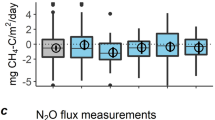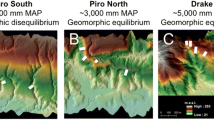Abstract
Topographic factors affect nitrogen cycling in forest soils, including nitrous oxide (N2O) emissions, which contribute to the greenhouse effect. We measured the N2O flux at 14 chambers placed along a 65-m transect on a slope for 1 year at 2- to 3-week intervals. We applied a hierarchical Bayesian model with a conditional autoregressive (CAR) model to assess the spatiotemporal N2O flux along a slope and quantify the effects of environmental factors on N2O emissions. N2O fluxes at chambers located at lower positions along the slope were relatively greater than those at higher positions. During the non-soil-freezing period, N2O fluxes fluctuated seasonally depending on soil temperature. The soil temperature dependency of N2O fluxes at each chamber increased with descending slope position (the median of the Q10 equivalent simulated from posterior distribution ranged from 1.18 to 3.64). According to the Bayesian hierarchical model, this trend could be partially explained by the C/N ratio at each chamber position. During the soil-freezing period, relatively high N2O fluxes were observed at lower positions along the slope.








Similar content being viewed by others
References
Adviento-Borbe MAA, Haddix ML, Binder DL, Walters DT, Dobermann A (2007) Soil greenhouse gas fluxes and global warming potential in four high-yielding maize system. Global Change Biol 13:1972–1988
Besag J, York JC, Molife A (1991) Bayesian image restoration with two applications in spatial statistics (with discussion). Ann Inst Stat Math 43:1–59
Brumme R (1995) Mechanism of carbon and nutrient release and retention in beech forest gaps. Plant Soil 168–169:593–600
Butterbach-Bahl K, Gasche R, Breuer L, Papen H (1997) Fluxes of NO and N2O from temperate forest soils: impact of forest type, N deposition and of liming on the NO and N2O emissions. Nutr Cycl Agroecosyst 48:79–90
Castaldi S (2000) Responses of nitrous oxide, dinitrogen and carbon dioxide production and oxygen consumption to temperature in forest and agricultural light-textured soils determined by model experiment. Biol Fertil Soil 32:67–72
Clark JS (2005) Why environmental scientists are becoming Bayesians. Ecol Lett 8:2–14
Crutzen PJ (1995) Ozone in the troposphere. In: Sing HB (ed) Composition, chemistry and climate of the atmosphere. Van Nostrand Reinhold Publ, New York, pp 349–393
Danielson RE, Sutherland PL (1986) Porosity. In: Kulute A (ed) Method of soil analysis, part I—physical and mineralogical methods, 2nd edn. Soil Science Society of America, Madison, WI, pp 443–461
Davidson EA, Ishida FY, Nepstad DC (2004) Effect of an experimental drought on soil emission of carbon dioxide, methane, nitrous oxide, and nitric oxide in a moist tropical forest. Global Change Biol 10:718–730
Gelfand AE, Latimer A, Wu S, Silander JA Jr (2005) Building statistical models to analyze species distribution. In: Clark JE, Gelfand AE (eds) Hierarchical modeling for the environmental sciences, statistical methods and applications. Oxford University Press, Oxford, pp 76–97
Groffman PM, Driscoll CT, Fahey TJ, Hardy JP, Fitzhugh RD, Tierney GL (2001) Colder soils in a warmer world: a snow manipulation study in a northern hardwood forest ecosystem. Biogeochemistry 56:135–150
Hardy JP, Groffman PM, Fitzhugh RD, Henry KS, Welman AT, Demers JD, Fahey TJ, Driscoll CT, Tierney GL, Nolan S (2001) Snow depth manipulation and its influence on soil frost and water dynamics in a northern hardwood forest. Biogeochemistry 56:151–174
Hawkins MJ, Hyde BP, Ryan M, Schulte RPO, Connolly J (2007) An empirical model and scenario of nitrous oxide emissions from a fertilized and grazed grass land site in Ireland. Nutr Cycl Agroecosyst 79:93–101
Hirobe M, Tokuchi N, Iwatubo G (1998) Spatial variability of soil nitrogen transformation patterns along a forest slope in Cryptomeria japonica D. Don plantation. Eur J Soil Biol 34:123–131
Hutchinson GL, Mosier A (1981) Improved soil cover method for field measurement of nitrous oxide fluxes. Soil Sci Soc Am J 45:311–316
IPCC (2001) Climate change 2001: the scientific basis. International panel on climate change. Cambridge University Press, Cambridge, UK
Ishizuka S, Sakata T, Ishizuka K (2000) Methane oxidation in Japanese forest soils. Soil Biol Biochem 32:769–777
Ishizuka S, Iswandi A, Nakajima Y et al (2005) Spatial patterns of greenhouse gas emission in a tropical rainforest in Indonesia. Nutr Cycl Agroecosyst 71:55–62
Konda R, Ohta S, Ishizuka S, Arai S, Ansori S, Tanaka N, Hardjono A (2008) Spatial structures of N2O, CO2 and CH4 fluxes from Acacia mangium plantation soils during a relatively dry season in Indonesia. Soil Biol Biochem 40:3021–3030. doi:10.1016/j.soilbio.2008.08.022
Lark RM, Milne AE, Addiscott TM, Goulding KWT, Webster CP, O’Flaherty S (2004) Scale- and location-dependent correlation of nitrous oxide emissions with soil properties: an analysis using wavelets. Eur J Soil Sci 55:611–627
Maag M, Vinther FP (1996) Nitrous oxide emission by nitrification and denitrification in different soil types and at different soil moisture contents and temperatures. Appl Soil Ecol 4:5–14
Maljanen M, Kohonen AR, Virkajarvi P, Martikainen PJ (2007) Fluxes and production ox N2O, CO2 and CH4 in boreal agricultural soil during winter as affected by snow cover. Tellus 59B:853–859
McSwiney CP, McDowell WH, Keller M (2001) Distribution of nitrous oxide and regulator of its production across a tropical rainforest catena in the Luquillo Experimental Forest, Puerto Rico. Biogeochemistry 56:265–286
Morishita T, Sakata T, Takahashi M et al (2007) Methane uptake and nitrous oxide emission in Japanese forest soils and their relationship to soil and vegetation types. Soil Sci Plant Nutr 53:678–691
Mosier AR (1998) Soil processes and global change. Biol Fertil Soils 27:221–229
Nishina K, Takenaka C, Ishizuka S (2009) Spatial variations in nitrous oxide and nitric oxide emission potential on a slope of Japanese cedar (Cryptomeria japonica) forest. Soil Sci Plant Nutr 55:179–189. doi:10.1111/j.1747-0765.2007.00315.x
Osaka K, Ohte N, Koba K, Katsuyama M, Nakajima T (2006) Hydrologic controls on nitrous oxide production and consumption in a forested headwater catchment in central Japan. J Geophys Res 111:G01013. doi:10.1029/2005JG000026
Papen H, Butterbach-Bahl K (1999) A 3-year continuous record of nitrogen trace gas fluxes from untreated and limed soil of a N-saturated spruce and beech forest ecosystem in Germany 1. N2O emissions. J Geophys Res 104:18487–18503
Parkin TB, Robinson JA (1989) Stochastic models of soil denitrification. Appl Environ Microbiol 55:72–77
Schoeneberger PJ, Wysocki DA, Benham EC, Broderson WD (1998) Field book for describing and sampling soils. U.S. Department of Agriculture, Natural Resources Conservation Service, National Soil Survey Center, Lincoln, NE
Smith KA (1997) The potential for feedback effects induced by global warning on emissions of nitrous oxide by soils. Global Change Biol 3:327–338
Smith KA, Thomson PE, Clayton H, McTaggart IP, Conen F (1998) Effect of temperature, water content and nitrogen fertilization on emissions of nitrous oxide by soils. Atmos Environ 32:3301–3309
Smith KA, Ball F, Conen KE, Dobbie KE, Massheder J, Rey A (2003) Exchange of greenhouse gases between soil and atmosphere: interactions of soil physical factors and biological processes. Eur J Soil Sci 54:779–791
Spiegelhalter DTA, Best N (2000) WinBUGS user manual. MRC Biostatistics Unit, Cambridge, UK
Stow CA, Recknow KH, Qian SS (2006) A Bayesian approach to retransformation bias in transformed regression. Ecology 87:1472–1477
Tang X, Liu S, Zhou G, Zhang D, Zhou C (2006) Soil atmospheric exchange of CO2, CH4 and N2O in three subtropical forest ecosystems in southern china. Global Change Biol 12:546–560
Teepe R, Brumme R, Beese F (2000) Nitrous oxide emissions from frozen soils under agricultural, fallow and forest land. Soil Biol Biochem 32:1807–1810
Teepe R, Brumme R, Beese F (2001) Nitrous oxide emissions from soil during freezing and thawing periods. Soil Biol Biochem 33:1269–1275
Teepe R, Vor A, Beese F, Ludwig B (2004) Emissions of N2O from soils during cycles of freezing and thawing and the effect of soil water, texture and duration of freezing. Eur J Soil Sci 55:357–365
USDA-NRCS (1999) Soil taxonomy, 2nd edn. http://soils.usda.gov/technical/classification/taxonomy/
Velthof GL, Jarvis SC, Stein A, Allen AG, Oenema O (1996) Spatial variability of nitrous oxide fluxes in mown and grazed grasslands on a poorly drained clay soil. Soil Biol Biochem 28:1215–1225
von Arnord K, Ivarsson M, Oqvist M, Majdi H, Bjork RG, Weslien P, Klemedtsson L (2005a) Can distribution of trees explain variation in nitrous oxide fluxes? Scand J For Res 20:481–489
von Arnord K, Nilsson M, Hanell B, Weslien P, Klemedtsson L (2005b) Fluxes CO2, CH4 and N2O from drained organic soils in deciduous forest. Soil Biol Biochem 37:1059–1071
Yanai Y, Toyota K, Okazaki M (2004) Effects of successive soil freeze thaw cycles on soil microbial biomass and organic matter decomposition potential of soils. Soil Sci Plant Nutr 50:821–829
Yoshida T, Hijii N (2006) Spatiotemporal distribution of aboveground litter in a Cryptomeria japonica plantation. J For Res 11:419–426
Acknowledgments
We are grateful to the staff of the Nagoya University experimental forest, especially Mr. Y. Imaizumi, Mr. N. Yamaguchi, and Mr. N. Takabe, for their support. We thank Dr. T. Yoshida for his valuable comments and help with sampling, and Dr. I. Tamaki for his valuable comments regarding statistical modeling.
Author information
Authors and Affiliations
Corresponding author
Rights and permissions
About this article
Cite this article
Nishina, K., Takenaka, C. & Ishizuka, S. Spatiotemporal variation in N2O flux within a slope in a Japanese cedar (Cryptomeria japonica) forest. Biogeochemistry 96, 163–175 (2009). https://doi.org/10.1007/s10533-009-9356-2
Received:
Accepted:
Published:
Issue Date:
DOI: https://doi.org/10.1007/s10533-009-9356-2




